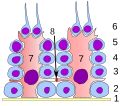Sertoli cell
Sertoli cells are a type of cell found in the testis, specifically in the seminiferous tubules. They are named after the Italian physiologist Enrico Sertoli, who discovered them. Sertoli cells play a crucial role in spermatogenesis, the process of sperm production.
Function[edit]
Sertoli cells are responsible for creating a blood-testis barrier, a physical barrier between the blood vessels and the seminiferous tubules in the testis. This barrier is essential for protecting the developing sperm cells from the immune system, as the sperm cells are recognized as foreign bodies due to their half set of chromosomes.
In addition to creating the blood-testis barrier, Sertoli cells also provide nourishment for the developing sperm cells and regulate the process of spermatogenesis. They secrete various substances that are necessary for the development and maturation of sperm cells, including androgen binding protein (ABP), inhibin, and activin.
Structure[edit]
Sertoli cells are large, columnar cells that extend from the basement membrane of the seminiferous tubules to the lumen. They have a complex structure with numerous cytoplasmic processes that envelop the developing sperm cells. The nucleus of a Sertoli cell is typically oval or elongated and contains one or more prominent nucleoli.
Clinical significance[edit]
Abnormalities in Sertoli cells can lead to various reproductive disorders. For example, Sertoli cell-only syndrome is a condition in which only Sertoli cells, but no sperm cells, are present in the seminiferous tubules. This condition leads to male infertility. Sertoli cells can also become cancerous, leading to a rare type of testicular cancer known as a Sertoli cell tumor.
See also[edit]
References[edit]
<references />
Ad. Transform your life with W8MD's Budget GLP-1 injections from $75


W8MD offers a medical weight loss program to lose weight in Philadelphia. Our physician-supervised medical weight loss provides:
- Weight loss injections in NYC (generic and brand names):
- Zepbound / Mounjaro, Wegovy / Ozempic, Saxenda
- Most insurances accepted or discounted self-pay rates. We will obtain insurance prior authorizations if needed.
- Generic GLP1 weight loss injections from $75 for the starting dose.
- Also offer prescription weight loss medications including Phentermine, Qsymia, Diethylpropion, Contrave etc.
NYC weight loss doctor appointmentsNYC weight loss doctor appointments
Start your NYC weight loss journey today at our NYC medical weight loss and Philadelphia medical weight loss clinics.
- Call 718-946-5500 to lose weight in NYC or for medical weight loss in Philadelphia 215-676-2334.
- Tags:NYC medical weight loss, Philadelphia lose weight Zepbound NYC, Budget GLP1 weight loss injections, Wegovy Philadelphia, Wegovy NYC, Philadelphia medical weight loss, Brookly weight loss and Wegovy NYC
|
WikiMD's Wellness Encyclopedia |
| Let Food Be Thy Medicine Medicine Thy Food - Hippocrates |
Medical Disclaimer: WikiMD is not a substitute for professional medical advice. The information on WikiMD is provided as an information resource only, may be incorrect, outdated or misleading, and is not to be used or relied on for any diagnostic or treatment purposes. Please consult your health care provider before making any healthcare decisions or for guidance about a specific medical condition. WikiMD expressly disclaims responsibility, and shall have no liability, for any damages, loss, injury, or liability whatsoever suffered as a result of your reliance on the information contained in this site. By visiting this site you agree to the foregoing terms and conditions, which may from time to time be changed or supplemented by WikiMD. If you do not agree to the foregoing terms and conditions, you should not enter or use this site. See full disclaimer.
Credits:Most images are courtesy of Wikimedia commons, and templates, categories Wikipedia, licensed under CC BY SA or similar.
Translate this page: - East Asian
中文,
日本,
한국어,
South Asian
हिन्दी,
தமிழ்,
తెలుగు,
Urdu,
ಕನ್ನಡ,
Southeast Asian
Indonesian,
Vietnamese,
Thai,
မြန်မာဘာသာ,
বাংলা
European
español,
Deutsch,
français,
Greek,
português do Brasil,
polski,
română,
русский,
Nederlands,
norsk,
svenska,
suomi,
Italian
Middle Eastern & African
عربى,
Turkish,
Persian,
Hebrew,
Afrikaans,
isiZulu,
Kiswahili,
Other
Bulgarian,
Hungarian,
Czech,
Swedish,
മലയാളം,
मराठी,
ਪੰਜਾਬੀ,
ગુજરાતી,
Portuguese,
Ukrainian





